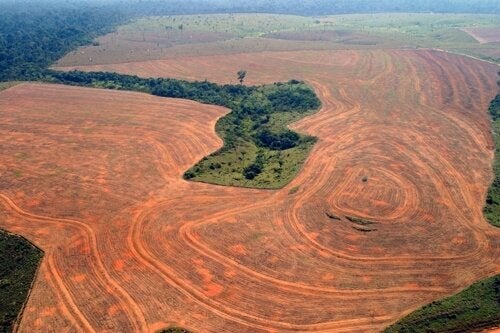
Last year José Carlos Meirelles, who works for the Brazilian government agency set up to protect the country's indigenous populations, released photographs that captivated the public imagination. Taken from an airplane swooping over the Amazon jungle, the pictures showed a group of Indians--their faces streaked with war paint, their bows drawn with arrows--that were said to remain uncontacted by the outside world.
Meirelles said that he had released the photographs to protect the tribe's territory from the onslaught of prospectors and loggers and farmers. In pursuit of such bountiful land, settlers had denied there were any remaining uncontacted Indians, and had mounted a campaign to open these territories for commercial use.
A few days after the photographs were made public, reports in the media surfaced that seemed to confirm the settlers' contention: the images were labeled "fakes," and widely dismissed as part of a "hoax," a "fraud," and a "PR joke."
Yet this perception was deeply misleading, and has had severe repercussions for the Indians in the region. As I document in my new book "The Lost City of Z: A Tale of Deadly Obsession in the Amazon," even today parts of the Amazon--a wilderness area virtually the size of the continental United States--remain unknown. The Brazilian government estimates that there are more than sixty tribes that are secluded in the jungle. John Hemming, the distinguished historian of Brazilian Indians, has said that these forests are almost "the only place on earth where indigenous people can survive in isolation from the rest of mankind."
The dispute over the photographs stemmed from confusion over the meaning of "uncontacted," as these groups are commonly designated. Though Meirelles had never said the tribe was unknown, many in the press had initially portrayed the group as such. In fact, like many of these tribes, the group's existence had had long been known about--its presence detected either by frontiersmen or by satellite imagery. Indeed, it is likely that many of these tribes have had some form of fleeting "contact" with outsiders over the years.
But that did not make the photographs "fakes" or a "hoax." The reason these tribes are classified as "uncontacted" is because they have retreated into the jungle and consciously avoided any interaction with settlers--an interaction that has frequently led to the extinction of Amazonian tribes.
In 2005, I visited the Kalapalo Indians in the southern basin of the Amazon. The tribe lived in the Xingu, which is part of Brazil's first Indian reservation. (It was created in 1961.) While the tribe had been contacted by the Brazilian government several decades earlier, its fate gives some sense of the threat to these indigenous communities.
While I was there, I spoke with a member of the tribe named Vanite, whose job was to guard one of the posts on the reservation. He told me that the other day an Indian had come to him and said, "Listen, Vanite. You must come with me down the river. The white people are building something in Afasukugu." The word "Afasukugu" meant "the place of the big cats"; at this site, the Kalapalos believe, the first humans were created. Vanite picked up a stick and drew a map on the mud floor. "Here is Afasukugu," he said. "It is by a waterfall."
Vanite paused for a moment, then continued with his story. "So I said, 'I will go with you to Afasukugu, but you are crazy. Nobody would build anything at the place of the jaguars.' But when I get there the waterfall is destroyed. They blew it up with thirty kilos of dynamite. The place was so beautiful, and now it is gone. And I ask a man working there, 'What are you doing?' He says, 'We are building a hydroelectric dam.' "
The dam was being built in the middle of a major river that ran through the Kalapalos' territory. Vanite, who was becoming more agitated, said, "A man from the [Brazilian] government comes to the Xingu and tells us, 'Do not worry. This dam will not hurt you.' And he offers each us of money. One of the chiefs from another tribe took the money, and the tribes are now fighting with each other. For me, the money means nothing. The river has been here for thousands of years. We don't live forever, but the river does. The god Taugi created the river. It gives us our food, our medicines. You see, we don't have a well. We drink water right from the river. How will we live without it?"
After Vanite finished his account, the chief of the Kalapalos, who was standing beside him, concluded, "If they succeed, the river will disappear and, with it, all our people."